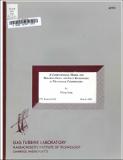A computational model for rotating stall and inlet distortions in multistage compressors
Author(s)
Gong, Yifang, 1964-
Download55992116.pdf (11.32Mb)
Other Contributors
Massachusetts Institute of Technology. Gas Turbine Laboratory
Metadata
Show full item recordAbstract
This thesis presents the conceptualization and development of a computational model for describing three-dimensional non-linear disturbances associated with instability and inlet distortion in multistage compressors. Specifically, the model is aimed at simulating the non-linear aspects of short wavelength stall inception, part span stall cells, and compressor response to three-dimensional inlet distortions. The computed results demonstrated the first-of-a-kind capability for simulating short wavelength stall inception in multistage compressors. The adequacy of the model is demonstrated by its application to reproduce the following phenomena: (1) response of a compressor to a square-wave total pressure inlet distortion; (2) behavior of long wavelength small amplitude disturbances in compressors; (3) short wavelength stall inception in a multistage compressor and the occurrence of rotating stall inception on the negatively sloped portion of the compressor characteristic; (4) progressive stalling behavior in the first stage in a mismatched multistage compressor; (5) change of stall inception type (from modal to spike and vice versa) due to IGV stagger angle variation, and "unique rotor tip incidence" at these points where the compressor stalls through short wavelength disturbances. The model has been applied to determine the parametric dependence of instability inception behavior in terms of amplitude and spatial distribution of initial disturbance, and intra-blade-row gaps. It is found that reducing the inter-blade row gaps suppresses the growth of short wavelength disturbances. It is also concluded from these parametric investigations that each local component group (rotor and its two adjacent stators) has its own instability point (i.e. conditions at which disturbances are sustained) for short wavelength disturbances, with the instability point for the compressor set by the most unstable component group. For completeness, the methodology has been extended to describe finite amplitude disturbances in high-speed compressors. Results are presented for the response of a transonic compressor subjected to inlet distortions.
Description
March 1999 Includes bibliographical references (pages 175-182)
Date issued
1999Publisher
Cambridge, Mass. : Gas Turbine Laboratory, Massachusetts Institute of Technology, [1999]
Series/Report no.
GTL report #230